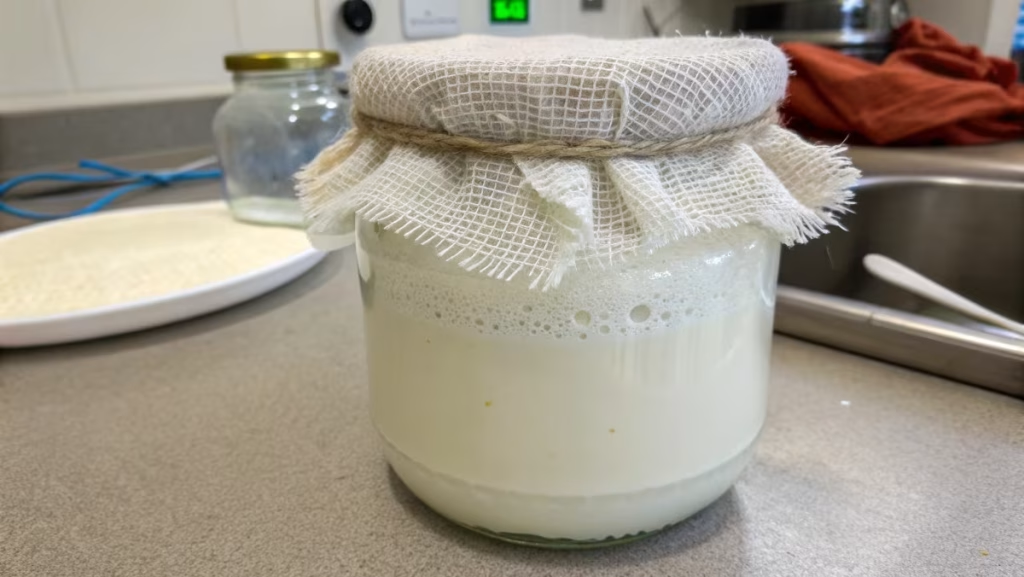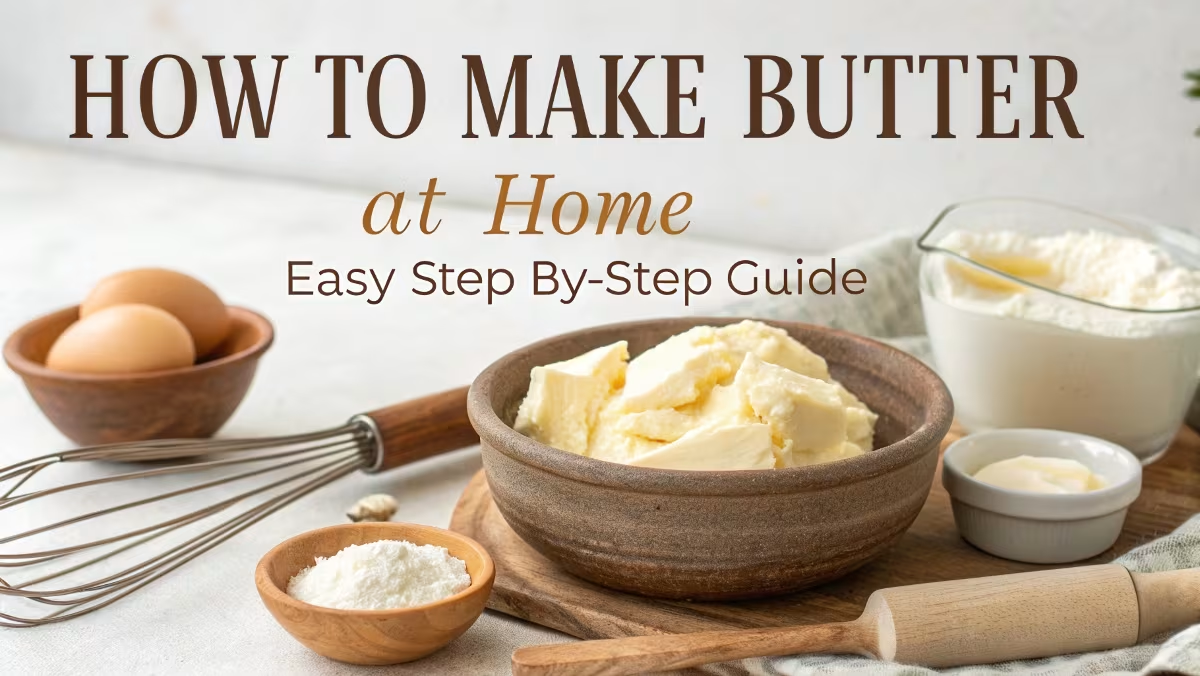Making butter at home is one of the easiest and most satisfying kitchen projects you can try. With just cream and a little effort, you can create rich, creamy butter that tastes far better than anything from the store. Plus, it’s a fun activity to do with kids or as a way to connect with old-fashioned cooking methods.
In this detailed guide, I’ll walk you through every step of making butter, from choosing the best cream to storing your finished product. I’ll also share tips, troubleshooting advice, and creative ways to flavor your homemade butter.
Why You Should Make Butter at Home
Before we get into the how-to, let’s talk about why homemade butter is worth the effort:
✅ Better Flavor – Fresh butter has a rich, creamy taste that store-bought versions can’t match.
✅ No Additives – Many commercial butters contain preservatives or artificial flavors. Yours will be 100% natural.
✅ Cost-Effective – Heavy cream often goes on sale, making homemade butter cheaper than premium brands.
✅ Fun & Educational – Great for teaching kids where food comes from.
✅ Customizable – You control the salt level and can add herbs, honey, or spices.
What You’ll Need to Make Butter
Ingredients:
- Heavy cream or whipping cream (at least 35% fat) – Avoid ultra-pasteurized if possible.
- Salt (optional) – For flavor and preservation.
Equipment:
- Stand mixer, hand mixer, or food processor (fastest method)
- Mason jar with lid (for the shaking method)
- Bowl
- Strainer or cheesecloth
- Spatula or wooden spoon
- Cold water (for rinsing)
Step-by-Step: How to Make Butter
1. Choosing the Right Cream
Not all cream works the same for butter-making. Here’s what to look for:
✔ Heavy cream or whipping cream (minimum 35% fat)
✔ Preferably organic or grass-fed (better flavor and texture)
❌ Avoid ultra-pasteurized cream (harder to turn into butter)
Tip: If you have access to raw milk, you can skim the cream off the top and use that for an even more traditional butter.
2. Whipping the Cream
- Pour 2 cups of cold cream into a mixing bowl.
- Start mixing on medium speed (if using a stand mixer, the whisk attachment works best).
- Within 2-3 minutes, it will turn into whipped cream (stop here if you just want whipped cream).
- Keep mixing until the cream breaks down—it will look grainy, then suddenly separate into butter solids and buttermilk.
What’s happening? The fat molecules in cream clump together, separating from the liquid (buttermilk).
3. Draining the Buttermilk
- Once the mixture separates, stop mixing.
- Place a strainer or cheesecloth over a bowl and pour the mixture through it.
- Save the liquid buttermilk for baking (great for pancakes, biscuits, or dressings).
4. Washing the Butter
- Rinse the butter under cold water while pressing it with a spatula.
- This removes any leftover buttermilk, which can make the butter spoil faster.
- Keep rinsing until the water runs clear.
5. Salting & Shaping (Optional)
- Add ¼ to ½ teaspoon of salt per cup of butter (if you like salted butter).
- Knead it gently to mix evenly.
- Shape it into a log, block, or balls (you can use parchment paper for easy shaping).
6. Storing Your Butter
- Fridge: Keeps for 2-3 weeks in an airtight container.
- Freezer: Lasts up to 6 months (wrap tightly in parchment or wax paper).

How to Make Cultured Butter (European-Style)
Cultured butter has a slightly tangy, rich flavor and is popular in French cuisine. Here’s how to make it:
Ingredients & Tools:
- 2 cups heavy cream (not ultra-pasteurized)
- 2 tbsp plain yogurt or buttermilk (with live cultures)
- Cheesecloth
- Glass jar
Steps:
- Culture the Cream:
- Mix cream with yogurt or buttermilk in a clean jar.
- Cover with cheesecloth and let sit at room temperature (70°F/21°C) for 12-24 hours.
- It should thicken slightly and develop a tangy smell.

- Churn the Butter:
- Follow the same steps as regular butter (mixer or jar method).
- The cultured cream will separate into butter and buttermilk.
- Rinse & Salt:
- Wash the butter under cold water.
- Add salt if desired (¼ tsp per cup).
Why Try Cultured Butter?
✔ Richer, tangier flavor
✔ Better for baking (flakier pastries)
✔ Closer to traditional European butter
How to Make Clarified Butter (Ghee)
Clarified butter (or ghee) has no milk solids, making it great for high-heat cooking.
Steps:
- Melt 1 cup of unsalted butter in a saucepan on low heat.
- Let it simmer gently until:
- The milk solids sink to the bottom.
- The liquid turns golden and clear.
- Strain through a cheesecloth into a jar.
- Discard the milk solids (or use them in baking).
Uses for Ghee:
- High-heat frying (won’t burn like regular butter)
- Keto & lactose-free diets
- Adds rich flavor to Indian dishes
Do you want to know how to make Butter from Milk?
How to Make Whipped Butter (Extra Fluffy)
Whipped butter is softer and easier to spread.
Steps:
- Make unsalted butter as usual.
- After rinsing, whip it again with a mixer for 1-2 minutes.
- Add 1-2 tbsp cold water while whipping to make it lighter.
Best Uses:
- Spreading on toast or muffins
- Frosting for cakes (mixed with sugar)
How to Make Flavored Compound Butters
Compound butter = butter + herbs/spices. Great for enhancing meals!
5 Easy Recipes:
- Garlic-Herb Butter
- Mix: ½ cup butter + 1 minced garlic clove + 1 tbsp chopped parsley
- Perfect for steak or garlic bread
- Honey-Cinnamon Butter
- Mix: ½ cup butter + 1 tbsp honey + ½ tsp cinnamon
- Great on pancakes or waffles
- Lemon-Dill Butter
- Mix: ½ cup butter + 1 tsp lemon zest + 1 tbsp fresh dill
- Delicious on fish or roasted veggies
- Spicy Chili Butter
- Mix: ½ cup butter + ½ tsp chili flakes + 1 tsp smoked paprika
- Amazing on corn on the cob
- Truffle Butter (Luxury Option)
- Mix: ½ cup butter + ½ tsp truffle oil
- Elevates pasta or mashed potatoes
Storage Tip: Roll compound butter in parchment paper, twist the ends, and freeze. Slice as needed!
Different Methods for Making Butter
1. Using a Mixer (Fastest Method – 10-15 mins)
Best for large batches. Works with a stand mixer, hand mixer, or food processor.
2. Shaking in a Jar (Fun & Traditional – 15-20 mins)
- Fill a mason jar halfway with cream.
- Shake vigorously until butter forms (great for kids to help!).
3. Using a Blender (Quick but Messy)
- Works fast but can splash buttermilk everywhere.
- Best for small batches.
Flavor Variations for Homemade Butter
Once you master basic butter, try these delicious twists:
1. Garlic Herb Butter
- Mix in minced garlic, parsley, and a pinch of salt.
- Perfect for garlic bread or grilled steak.
2. Honey Cinnamon Butter
- Add 1 tbsp honey + ½ tsp cinnamon.
- Amazing on pancakes, toast, or muffins.
3. Lemon Pepper Butter
- Stir in lemon zest + black pepper.
- Great for fish or roasted vegetables.
4. Truffle Butter (Fancy Option)
- Mix in a few drops of truffle oil.
- Elevates pasta, mashed potatoes, or risotto.
What to Do with Leftover Buttermilk
Don’t pour it out! Use it in:
- Fluffy pancakes or waffles
- Southern-style biscuits
- Salad dressings or marinades
- Tenderizing meat (great for fried chicken!)
Troubleshooting Common Butter-Making Problems
Problem: Butter Won’t Form
- Cause: Ultra-pasteurized cream or not enough fat.
- Fix: Use regular pasteurized heavy cream and keep mixing.
Problem: Butter Tastes Sour
- Cause: Old cream or leftover buttermilk.
- Fix: Use fresh cream and rinse butter thoroughly.
Problem: Butter is Too Soft
- Cause: Not enough rinsing or warm kitchen.
- Fix: Rinse with ice water and chill before shaping.
FAQs About Making Butter
1. How long does homemade butter last?
- Fridge: 2-3 weeks
- Freezer: Up to 6 months
2. Can I use milk instead of cream?
No—only high-fat cream (35% or more) will turn into butter.
3. Why isn’t my butter yellow like store-bought?
Most commercial butter is dyed. Grass-fed cow cream yields a slightly yellower butter.
4. Do I need to add salt?
No, but salt enhances flavor and helps preserve it.
5. Can I make butter without a mixer?
Yes! Shake cream in a jar until it separates.
6. Is homemade butter cheaper?
Often, yes—especially if you buy cream in bulk or on sale.
7. Can I use a blender?
Yes, but it can get messy. Pulse gently to avoid splashing.
8. Why does my butter smell weird?
If it smells sour, the cream may have been old. Always use fresh cream.
9. Can I make butter from raw milk?
Yes—skim the cream off the top and use that.
10. How do I make cultured butter?
Let cream sit at room temperature for 12-24 hours before churning (adds a tangy flavor).
Final Thoughts
Making butter at home is simple, rewarding, and a great way to enjoy pure, fresh dairy. Whether you use a mixer, a jar, or even a food processor, you’ll love the rich taste of homemade butter.
Now that you know how to make butter, why not try it today? Experiment with flavors, share it with friends, and enjoy the satisfaction of creating something delicious from scratch!

3 thoughts on “How to Make Butter at Home – Easy Step-by-Step Guide”